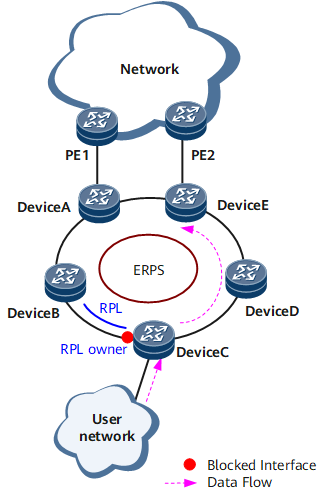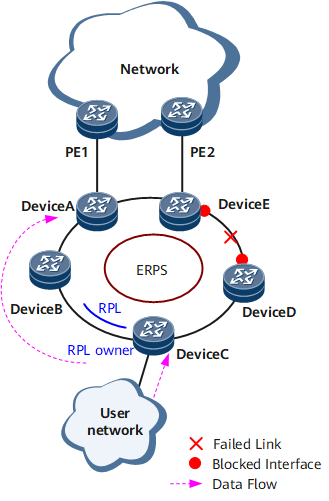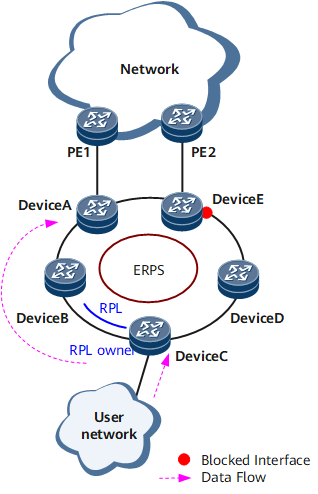ERPS Single Ring Fundamentals
ERPS is a standard ring protocol used to prevent loops on ERPS rings at the Ethernet link layer. A device can have a maximum of two ports added to the same ERPS ring.
To prevent loops on an ERPS ring, you can enable a loop-breaking mechanism to block the Ring Protection Link (RPL) owner port to eliminate loops. If a link on the ring network fails, the ERPS-enabled device immediately unblocks the blocked port and performs link switching to restore communication between nodes on the ring network.
This section describes how ERPS is implemented on a single ring when links are normal, when a link fails, and when the link recovers (including protection switching operations).
Links Are Normal
- To prevent loops, ERPS blocks the RPL owner port and also the RPL neighbor port (if any is configured). All other ports can transmit service traffic.
- The RPL owner port sends R-APS (NR) messages to all other nodes on the ring at an interval of 5s, indicating that ERPS links are normal.
A Link Fails
As shown in Figure 2, if the link between DeviceD and DeviceE fails, the ERPS protection switching mechanism is triggered. The ports on both ends of the faulty link are blocked, and the RPL owner port and RPL neighbor port are unblocked to send and receive traffic. This mechanism ensures that traffic is not interrupted. The process is as follows:
- After DeviceD and DeviceE detect the link fault, they block their ports on the faulty link and perform a Filtering Database (FDB) flush.
- DeviceD and DeviceE send three consecutive R-APS Signal Fail (SF) messages to the other LSWs and then send one R-APS (SF) message at an interval of 5s afterwards.
- After receiving an R-APS (SF) message, the other LSWs perform an FDB flush. DeviceC on which the RPL owner port resides and DeviceB on which the RPL neighbor port resides unblock the respective RPL owner port and RPL neighbor port, and perform an FDB flush.
The Link Recovers
After the link fault is rectified, either of two situations may occur:
- If the ERPS ring uses revertive switching, the RPL owner port is blocked again, and the link that has recovered is used to forward traffic.
- If the ERPS ring uses non-revertive switching, the RPL remains unblocked, and the link that has recovered remains blocked.
The following example uses revertive switching to describe the process after the link recovers.
- After the link between DeviceD and DeviceE recovers, DeviceD and DeviceE start a guard timer to avoid receiving out-of-date R-APS PDUs. The two devices do not receive any R-APS PDUs before the timer expires. At the same time, DeviceD and DeviceE send R-APS (NR) messages to the other LSWs.
- After receiving an R-APS (NR) message, DeviceC on which the RPL owner port resides starts the WTR timer. After the WTR timer expires, DeviceC blocks the RPL owner port and sends R-APS (NR, RB) messages.
- After receiving an R-APS (NR, RB) message, DeviceD and DeviceE unblock the ports at the two ends of the link that has recovered, stop sending R-APS (NR) messages, and perform an FDB flush. The other LSWs also perform an FDB flush after receiving an R-APS (NR, RB) message.
Protection Switching
Forced switch
On the network shown in Figure 3, DeviceA through DeviceE on the ERPS ring can communicate with each other. A forced switch (FS) operation is performed on the DeviceE's port that connects to DeviceD, and the DeviceE's port is blocked. The RPL owner port and RPL neighbor port are then unblocked to send and receive traffic. This ensures that traffic is not interrupted. The process is as follows:
- After the DeviceE's port that connects to DeviceD is forcibly blocked, DeviceE performs an FDB flush.
- DeviceE sends three consecutive R-APS (SF) messages to the other LSWs and then after 5s, sends another R-APS (SF) message.
- After receiving an R-APS (SF) message, the other LSWs perform an FDB flush. DeviceC on which the RPL owner port resides and DeviceB on which the RPL neighbor port resides unblock the respective RPL owner port and RPL neighbor port, and perform an FDB flush.
Clear
After a clear operation is performed on DeviceE, the port that is forcibly blocked by FS sends R-APS (NR) messages to all other ports on the ERPS ring.
- If the ERPS ring uses revertive switching, the RPL owner port starts the WTB timer after receiving an R-APS (NR) message. After the WTB timer expires, the FS operation is cleared. The RPL owner port is then blocked, and the blocked port on DeviceE is unblocked. If you perform a clear operation on DeviceC on which the RPL owner port resides before the WTB timer expires, the RPL owner port is immediately blocked, and the blocked port on DeviceE is unblocked.
- If the ERPS ring uses non-revertive switching and you want to block the RPL owner port, perform a clear operation on DeviceC on which the RPL owner port resides.
Manual switch
Compared with an FS operation, a manual switch (MS) operation triggers protection switching in a similar way except that an MS operation does not take effect in FS, MS, or link failure conditions.


